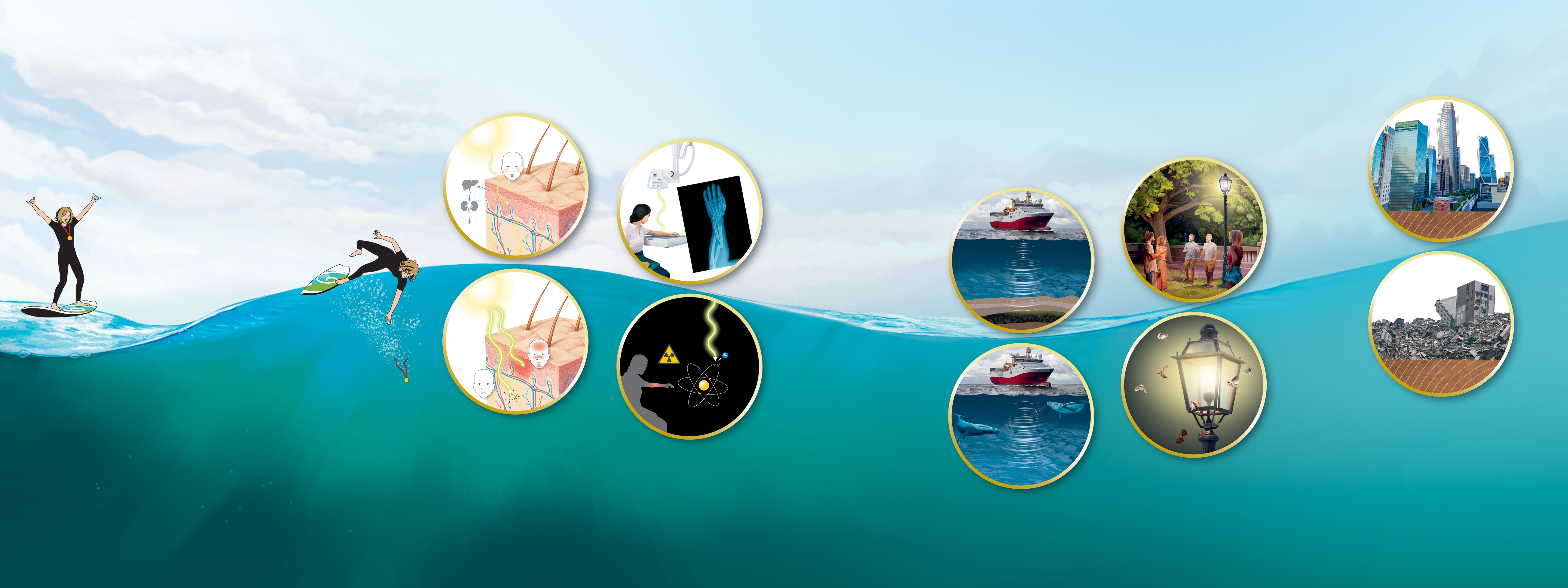Two Sides of the Same Coin
Using waves with all their opportunities and their risks
Waves are energy that we use in a variety of beneficial ways – naturally and technologically. But no use is without
risk – either for us or others. The extent of the risk varies depending on the wave and the situation.

For Whose Benefit
Technological advances open up new worlds for us. We can see and talk with people on the other side of the planet. We can search the seabed for mineral resources through enormous masses of water. But what is good for one may be bad for another.
The sound waves used in deep-sea resource exploration disturb animals like whales and dolphins, who use sound waves to communicate, hunt and find mates. Artificial light sources let us move around safely at night, but they impair animals’ ability to navigate and, if used excessively and incorrectly, can also harm humans.
The 5G mobile communication standard allows faster transmission of even larger amounts of data and offers great opportunities for innovation. On the other hand, citizens have concerns about radiation exposure. At the political level, there is discussion about what it means if the technology comes from another country. Is there a risk of foreign manipulation of central control channels with implications for energy supply, transport, the military or other critical infrastructure?
Waves are also used as weapons. Nuclear explosions release large amounts of gamma radiation and huge pressure waves. Acoustic weapons can cause painfully loud sounds and thus hearing damage.
It Is All in the Quantity
In order for the body to produce vitamin D, our skin needs the UV radiation contained in sunlight. However, if we stay in the sun for too long, our skin burns and ages faster. This is due to the energy that is carried in waves.
X-rays can detect broken bones, but they have so much energy that they can ionise. This means that they can knock particles (electrons) out of atoms and thus be harmful to the tissue. This is why we should keep our bodies’ exposure to X-rays to an absolute minimum. The visible light of a torch does not have this side effect; however, it also has too little energy to shine through the body.
Waves of the same wavelength can also have different effects depending on their intensity. Sound waves enable us to communicate, but if they have too much energy, their noise can damage our hearing and lead to stress.
Thus, when dealing with waves, we have to find a balance between harm and benefit.
Look Before Your Leap
Every day we make decisions that carry consequences. How do we make them? What information, standards and values do we use as guidance? What risks are we prepared to take for ourselves and others? Whether we know it or not, these questions also apply to our use of waves.
In earthquake zones, the risk of damage can be reduced by ensuring buildings are earthquake-proof and adopting safe behaviour. Nevertheless, a certain degree of risk remains and we have to weigh up whether the advantages of living in that region outweigh the disadvantages. The production of nuclear power is climate-friendly. A nuclear accident, however, can have devastating consequences (e.g. due to leaking gamma radiation). In addition, a solution for safe disposal of radioactive waste has not yet been found.
In our complex world, making responsible decisions is a big challenge. Often we have too much, too little or the wrong information, we do not understand it or it is contradictory. What is right for me may be wrong for nature and society. And some risks are only revealed after a longer period of time. We can counteract this uncertainty by handling new technologies with precaution. Good science and science communication provide important support to society and politics in their decision-making.